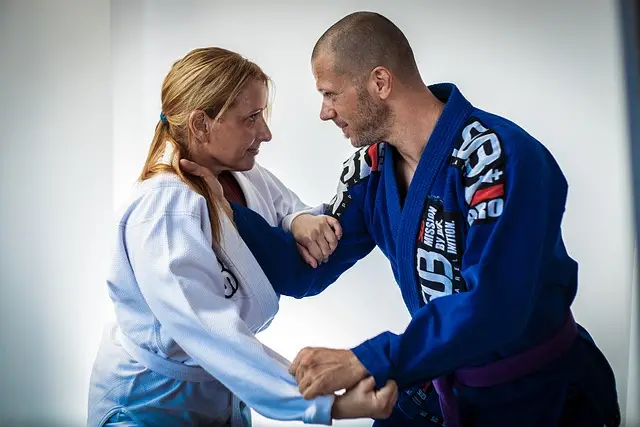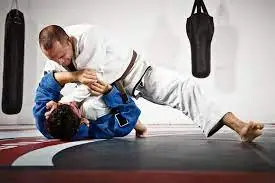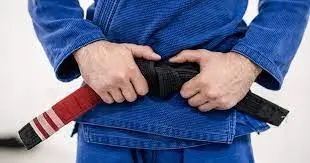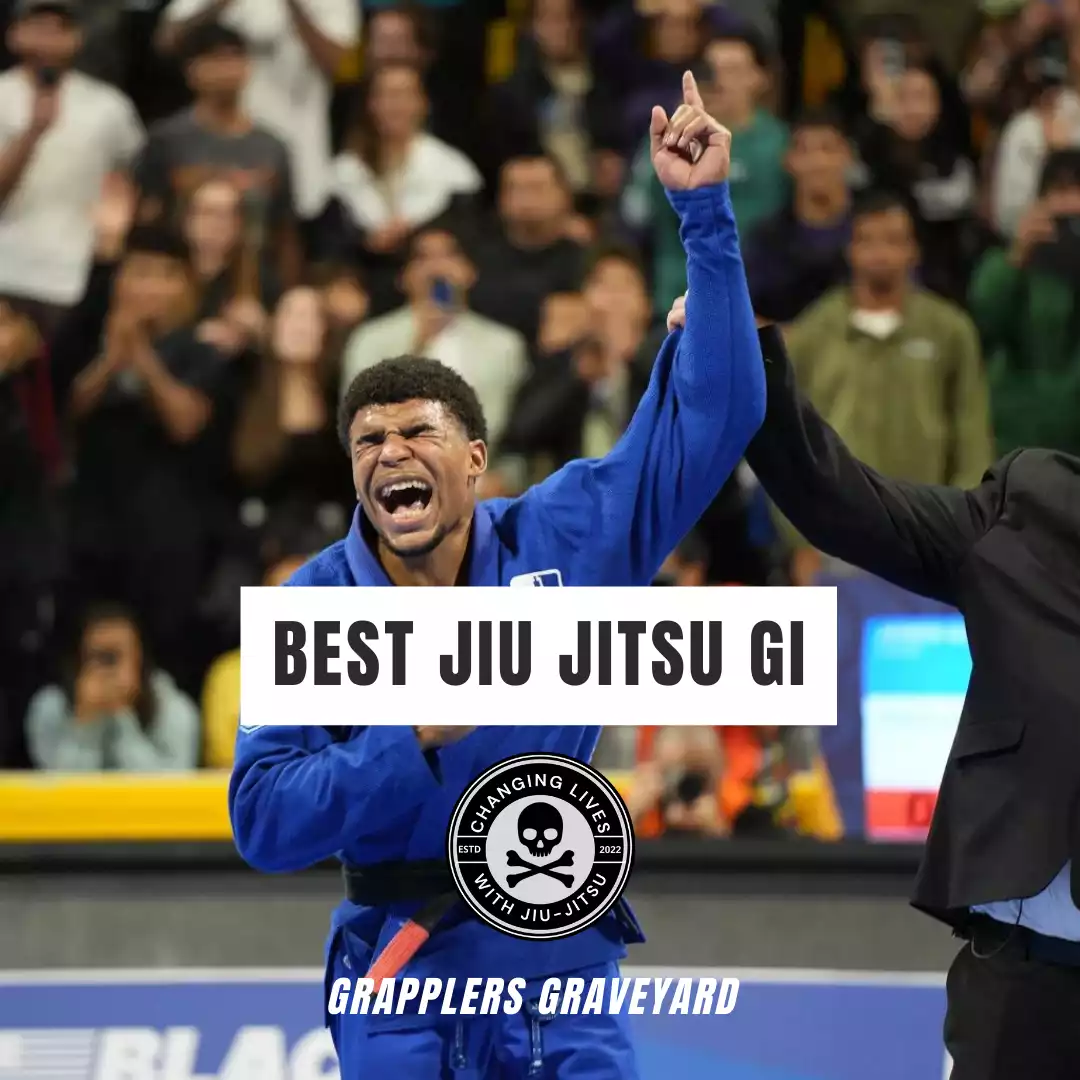Table of Contents
For both Juveniles and adults, the promotion to blue belt is a huge deal! BJJ practitioners spend hours multiple times a week, honing their skills and practicing their techniques.
Many athletes who are just getting into the sport of Jiu-Jitsu wonder how long it will take to be promoted to this next level.
What not many people know is that multiple factors play into the length of time between belt rankings.
So on average, how long does it take to make it to the blue belt rank?
How Long Does It Take To Get A Blue Belt In BJJ?
Short answer: The amount of time it takes for a white belt level practitioner to reach the ranking of blue typically spans from 1-3 years.
This all depends on the rate of progression, age, and attitude of the grappler. If you are seriously dedicated, you will have no problem getting that blue belt in a flash.
What Does Getting a Blue Belt in BJJ Mean?
Getting your blue belt in Jiu-Jitsu means that you are an experienced lower-rank student. Although you have some technique under your belt, you still have many years ahead of you to learn and master different techniques.
Enjoy this period of your journey. Enjoy the little moments of discovering new techniques to link together. Enjoy seeing the progression in your game and enjoy learning more about what it means to be a student in the art of BJJ
Jiu-Jitsu Blue Belt Requirements
There is only one, overarching requirement for all blue belts in the sport of BJJ. That requirement is that you must be over the age of 16 to compete as a blue belt.
It is not uncommon to get promoted a little before your 16th birthday but it is a requirement to be above the age of 15 to compete in the Juvenile and/or adult belt classes.
As a blue belt, there are a couple of things that you should surely know how to do. You should be able to not only escape inferior positions, but you should be at the skill level where you can attack from dominant positions as well.
You do not have to be a title master, but you should be subbing lower-ranked students and giving your BJJ coach a little bit harder time.
Factors Affecting How Long to Get Blue Belt
Many factors contribute to the length of time it takes to get promoted to a blue belt. For one, your age is extremely important.
If you are an 11-year-old yellow belt you are going to have to wait 5 years until you can get your blue belt. Additionally, if you are a lot older and you’re not able to participate too much in class, it may take you a little longer to get that promotion.
Age is not the only factor that is important when looking to answer this question. Before promotions, coaches look at effort level and attitude along with competition performance. If you are a high-performing athlete, with a great attitude and an even better work ethic, you will get your blue belt in no time!
How to Get Your BJJ Blue Belt Faster
There are plenty of ways to hasten the process of getting your blue belt.
-
Compete:
One of the simplest and most effective ways you can prove to your coach that you deserve the promotion to blue belt is to compete. It is in these competitions that your skills and techniques are truly tested.
Putting you against other white belts informs your coach on how prepared you are to take on blue belts in the future.
If you are winning all of your white belt brackets, it won’t be long until your instructor promotes you to challenge your technique in competition.
-
Come to class consistently:
Getting in the dojo more than a few times a week can be a difficult task for those who have work, family, and bills to worry about. But if you are truly trying to get your blue belt as fast as you can, it is in your best interest to show up as often as possible!
Being consistent with your training schedule and showing up 4-6 times a week is a great way to separate yourself as one of the hardest workers in the gym.
That being said, it is important to always show up to practice ready to learn. If you are messing around the whole time with some buddies and not drilling the technique properly, your instructor is not going to be ecstatic about promoting you any time soon.
-
Help around the dojo:
Being a blue belt isn’t simply about how good your technique is. Colored belts represent patience, kindness, and eagerness to learn.
If you want to be promoted faster, start helping out around your Jiu-Jitsu gym. Offer to sweep the mats, or help out at the front desk. A little efforts can go a long way.
Remember to do this out of kindness and appreciation, not only because you want that next promotion.
Premium fight wear for BJJ, MMA, & more. Shop a wide range of premium quality fight wear for mean, women, and kids at affordable prices.
BJJ Blue Belt vs Average Person
What would happen if you pinned a BJJ blue belt against an average guy off the street? The short answer; A blue belt would win 9/10 times.
Although, this number sharply relies on the play style of a Brazilian Jiu-Jitsu athlete. You see, unlike in competitive BJJ, pulling guard in the real world is an easy way to get your skull kicked in and an array of punches thrown your way.
That being said, the guard isn’t the only technique taught in BJJ. Several takedowns and high-quality submissions are taught that give the average blue belt an edge against a nobody on the street.
It takes a lot more effort to punch someone unconscious than it does to choke someone out.
Along with that, striking can seriously injure your fists making you unable to continue in the engagement.
If a blue belt gets their hands on the average person in a street fight, a blue belt should be able to take their opponent down and either hold them there until help arrives, or choke them unconscious and run away.
What Percent of White Belts Quit Before Making it to Blue Belt?
Due to everyday life, the majority of white belts end up leaving Brazilian Jiu-Jitsu before they achieve the rank of blue belt. Although it is sad to see many practitioner’s journeys end after just a short period, Jiu-Jitsu is not for everyone and sometimes people just simply do not have the time or desire to continue climbing the ranks
One of the main reasons people end up quitting Jiu-Jitsu is because of what’s known as burnout.
Burnout is the loss of interest and motivation typically in a sport or hobby. If you have been in the athletic world for long enough, I can guarantee you’ve experienced this unpleasant feeling before.
With all of that being said, how do you reduce your risk of burnout in Brazilian Jiu-Jitsu?
-
Cross Train:
Cross-training is the idea of practicing multiple different and unique martial arts to benefit your Jiu-Jitsu game.
For instance, If you practice BJJ 4 times a week, consider throwing in wrestling on one of your off days, the takedown and control techniques taught in the aggressive martial art will benefit your Jiu-Jitsu game immensely.
Not only that but absolutely nothing compares to the grit and endurance of wrestlers. Cross-train your sports, you won’t regret it!
-
Compete:
Competing is an essential part of keeping your motivation and determination high in Jiu-Jitsu. Training in your dojo with the same partners every day can get boring fast.
In addition, you may find that your progress is more difficult to track when you do not compete. The reason is, typically in your dojo, the majority of the practitioners are progressing at similar rates.
This means that you might feel like your technique isn’t getting any better when in reality both you and your teammate’s game has leveled up.
Competing allows you to test your skills and technique against opponents similar in size and experience level. Win or lose, tournaments give you experience and the motivation to work harder every day.
How many blue belts are there?

As of 2023, there are nearly 300,00 BJJ blue belts. These practitioners range from the age of 16 up to 70 years old!
It is incredible to see how many dedicated athletes there are in BJJ. It is difficult for those who don’t participate in martial arts to understand the difficulties that practitioners of combat sports must go through.
The constant drilling, extreme weight cuts, and inevitable burnout are bad enough. But due to the nature of combat sports, grapplers often have to take breaks from doing what they love due to an injury caused by overworking or accidents.
Although the path that martial artists take is difficult, it is extremely rewarding and worth every uncomfortable moment.
Should I Compete to go from White Belt to Blue Belt?
Absolutely! Competition is one of the healthiest and quickest ways to progress in any grappling art! When you step onto the mats during a competition, your skills are being tested against a man that is working towards the same goal as you. Having that healthy level of competition is super important for your personal growth in the sport.
Although it is easy to get excited over your next promotion, the best thing you can do for yourself is to forget about your rank when training.
When you focus on promotion instead of technique, your motivation begins to die out along with your determination to get better.
Sure, you will get the blue belt eventually, but then what? The best advice I can give to you is to enjoy the journey and take it slow. Don’t rush your progression, time is going to fly by either way.
Premium fight wear for BJJ, MMA, & more. Shop a wide range of premium quality fight wear for mean, women, and kids at affordable prices.
Time Spent On Average At Each Belt

As stated previously, many different factors go into the speed of your promotion, but here are the rough timelines of each belt rank.
White Belt

The white belt is arguably the most important belt promotion that you can ever get. Ascertaining your first belt means that you have become a student of the martial art and you are at the least willing to try to learn and develop your skills.
Once you begin your BJJ journey, there are going to be many ups and downs that you will have to face.
You may have incredible success one day and be submitted every round the next. If you can humble yourself, make it through those tough days, and continue learning and practicing, you won’t be a white belt for longer than 1-3 years.
Blue Belt

The blue belt is an interesting belt level because it is where the kids and adult rankings intertwine.
If you are not familiar with the sport of Jiu-Jitsu, kids under the age of 16 must go through a surplus of belts before reaching the rank of blue once they become a teenager.
Unlike their youthful counterparts, teens and adults above the age of 16 jump immediately from their white belt to their blue belt.
This is due to the lack of time adults have to train coupled with the fact that their career is going to be shorter than a practitioner who has trained since a very young age.
That being said, the transition from blue to purple is one of the longer ones, typically lasting 2-4 years.
Purple Belt

Being a purple belt means that you are no longer a newcomer to the sport of Brazilian Jiu-Jitsu. At this point, you probably have a solid base of the art. Although this belt is one of the transition colors, it is still extremely important to use the time you have as a purple belt to learn as much as possible and continue to compete in tournaments.
Many purple belts begin to get lazy in their day-to-day practice. It is essential to stay humble and to treat your learning as a white belt would.
As stated previously, the purple belt is a transition belt. For many Brazilian Jiu-Jitsu Hobbyists, it could take upwards to 3-4 years to get their brown belt. But for high-level competitors, the purple belt could only take a year or two to move on from depending on how well they perform in tournaments.
Brown Belt

The brown belt is one of the most important belts you will collect on your BJJ journey. When a student gets their brown belt, a few things happen.
Typically, once a practitioner starts getting close to the black belt level, they must prove that they can teach and help others. Brazilian Jiu-Jitsu is so much more than just a sport. BJJ is about having fun and helping others in the process. Once you collect your brown belt, it is a great idea to start helping to teach youth and/or adult BJJ classes.
Not only does teaching help the students, but it also helps the coach tighten up his game and reflect on the details of the technique.
Along with teaching, higher-level competition also comes into play. If you are a Brown Belt competitor, you are typically going to be getting some high-level competition in your brackets. Everyone is trying to prove that they are good enough to make it to the rank of black belt.
Moving on from the brown belt typically requires many years of experience, especially if you aren’t a competitor.
As stated previously, competing typically fast tracks a fighter through the ranks quicker than anything else. The average length of time that practitioners stay at brown belt could be anywhere from 3-4 years
Black belt

BJJ practitioners who have put in the mat time to get promoted to a black belt are truly disciplined individuals. It is a challenge to make it through all of the problematic practices, burnout, weight cuts, and every other trial and tribulation that the sport throws your way.
Though, contrary to popular belief, ascertaining your black belt is only the beginning of your Jiu-Jitsu journey. Once you get to this incredible milestone, you still have the rest of your life ahead of you.
One of the greatest parts of Brazilian Jiu-Jitsu is that you can still train far into your adult years. The majority of BJJ practitioners are above 30 years old!
BJJ athletes who are truly invested in the sport typically train until they are around 50. Once their bodies begin to break down, most black belts give back to their sport by teaching the youth practical techniques and lessons that they can carry throughout not only their Jiu-Jitsu career but their life as well.
Find the top-rated BJJ Gi's here. Helpful information on what to look for, how to find the best gi, and which brands suit you best based on your budget!
Frequently Asked Questions
What percentage of people make it to blue belt BJJ?
Typically, only 10 percent of white belts get promoted to their blue belt.
How long do people stay at Blue Belt BJJ?
Typically, the average practitioner stays at this belt for around 2-4
Is getting your blue belt in BJJ a big deal?
It is! Being promoted to blue belt means that you are committed and experienced in the sport of Jiu-Jitsu.
How hard is it to get a blue belt in BJJ?
Getting promoted to any belt in BJJ is challenging. Due to the fact that the blue belt is the first rank that adults get after their white belt, the promotion from one to the other can seem extra challenging.




